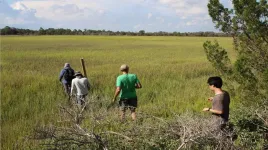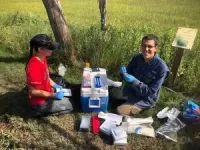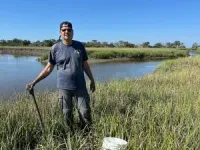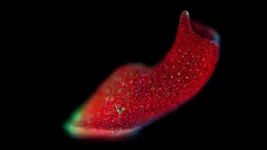(Press-News.org) Georgia’s saltwater marshes — living where the land meets the ocean — stretch along the state’s entire 100-mile coastline. These rich ecosystems are largely dominated by just one plant: grass.
Known as cordgrass, the plant is an ecosystem engineer, providing habitats for wildlife, naturally cleaning water as it moves from inland to the sea, and holding the shoreline together so it doesn’t collapse. Cordgrass even protects human communities from tidal surges.
Understanding how these plants stay healthy is of crucial ecological importance. For example, one known plant stressor prevalent in marsh soils is the dissolved sulfur compound, sulfide, which is produced and consumed by bacteria. But while the Georgia coastline boasts a rich tradition of ecological research, understanding the nuanced ways bacteria interact with plants in these ecosystems has been elusive. Thanks to recent advances in genomic technology, Georgia Tech biologists have begun to reveal never-before-seen ecological processes.
The team’s work was published in Nature Communications.
Joel Kostka, the Tom and Marie Patton Distinguished Professor and associate chair for Research in the School of Biological Sciences, and Jose Luis Rolando, a postdoctoral fellow, set out to investigate the relationship between the cordgrass Spartina alterniflora and the microbial communities that inhabit their roots, identifying the bacteria and their roles.
“Just like humans have gut microbes that keep us healthy, plants depend on microbes in their tissues for health, immunity, metabolism, and nutrient uptake,” Kostka said. “While we’ve known about the reactions that drive nutrient and carbon cycling in the marsh for a long time, there’s not as much data on the role of microbes in ecosystem functioning.”
Out in the Marsh
A major way that plants get their nutrients is through nitrogen fixation, a process in which bacteria convert nitrogen into a form that plants can use. In marshes, this role has mostly been attributed to heterotrophs, or bacteria that grow and get their energy from organic carbon. Bacteria that consume the plant toxin sulfide are chemoautotrophs, using energy from sulfide oxidation to fuel the uptake of carbon dioxide to make their own organic carbon for growth.
“Through previous work, we knew that Spartina alterniflora has sulfur bacteria in its roots and that there are two types: sulfur-oxidizing bacteria, which use sulfide as an energy source, and sulfate reducers, which respire sulfate and produce sulfide, a known toxin for plants,” Rolando said. “We wanted to know more about the role these different sulfur bacteria play in the nitrogen cycle.”
Kostka and Rolando headed to Sapelo Island, Georgia, where they have regularly conducted fieldwork in the salt marshes. Wading into the marsh, shovels and buckets in hand, the researchers and their students collected cordgrass along with the muddy sediment samples that cling to their roots. Back at the field lab, the team gathered around a basin filled with creek water and carefully washed the grass, gently separating the plant roots.
Next, they used a special technique involving heavier versions of chemical elements that occur in nature as tracers to track the microbial processes. They also analyzed the DNA and RNA of the microbes living in different compartments of the plants.
Using a sequencing technology known as shotgun metagenomics, they were able to retrieve the DNA from the whole microbial community and reconstruct genomes from newly discovered organisms. Similarly, untargeted RNA sequencing of the microbial community allowed them to assess which microbial species and specific functions were active in close association with plant roots.
Using this combination of techniques, they found that chemoautotrophic sulfur-oxidizing bacteria were also involved in nitrogen fixation. Not only did these bacteria help plants by detoxifying the root zone, but they also played a crucial role in providing nitrogen to the plants. This dual role of the bacteria in sulfur cycling and nitrogen fixation highlights their importance in coastal ecosystems and their contribution to plant health and growth.
"Plants growing in areas with high levels of sulfide accumulation tend to be smaller and less healthy," said Rolando. "However, we found that the microbial communities within Spartina roots help to detoxify the sulfide, enhancing plant health and resilience."
Local to Global Significance
Cordgrasses aren’t just the main player in Georgia marshes; they also dominate marsh landscapes across the entire Southeast, including the Carolinas and the Gulf Coast. Moreover, the researchers found that the same bacteria are associated with cordgrass, mangrove, and seagrass roots in coastal ecosystems across the planet.
"Much of the shoreline in tropical and temperate climates is covered by coastal wetlands,” Rolando said. “These areas likely harbor similar microbial symbioses, which means that these interactions impact ecosystem functioning on a global scale."
Looking ahead, the researchers plan to further explore the details of how marsh plants and microbes exchange nitrogen and carbon, using state-of-the-art microscopy techniques coupled with ultra-high-resolution mass spectrometry to confirm their findings at the single-cell level.
"Science follows technology, and we were excited to use the latest genomic methods to see which types of bacteria were there and active,” Kostka said. “There's still much to learn about the intricate relationships between plants and microbes in coastal ecosystems, and we are beginning to uncover the extent of the microbial complexity that keeps marshes healthy.”
Citation: Rolando, J.L., Kolton, M., Song, T. et al. Sulfur oxidation and reduction are coupled to nitrogen fixation in the roots of the salt marsh foundation plant Spartina alterniflora. Nat Commun 15, 3607 (2024).
DOI: https://doi.org/10.1038/s41467-024-47646-1
Funding: This work was supported in part by an institutional grant (NA18OAR4170084) to the Georgia Sea Grant College Program from the National Sea Grant Office, National Oceanic and Atmospheric Administration, US Department of Commerce, and by a grant from the National Science Foundation (DEB 1754756).
#####
The Georgia Institute of Technology, or Georgia Tech, is one of the top public research universities in the U.S., developing leaders who advance technology and improve the human condition. The Institute offers business, computing, design, engineering, liberal arts, and sciences degrees. Its more than 45,000 undergraduate and graduate students, representing 50 states and more than 148 countries, study at the main campus in Atlanta, at campuses in France and China, and through distance and online learning. As a leading technological university, Georgia Tech is an engine of economic development for Georgia, the Southeast, and the nation, conducting more than $1 billion in research annually for government, industry, and society.
END
From roots to resilience: investigating the vital role of microbes in coastal plant health
2024-05-15
ELSE PRESS RELEASES FROM THIS DATE:
Q&A: How did the COVID-19 pandemic affect older adults’ technology use?
2024-05-15
The onset of the COVID-19 pandemic changed how nearly everyone mediated their social interactions through technology. Some moved happy hours into video chats. Others delved deeper into social media, or took a step back from it. Millions of people worked or learned through computers.
University of Washington researchers took particular interest in how this tech shift affected older adults’ social relationships. The team interviewed 16 older adults in Washington and Oregon, ages 65 to 80, about how their technology ...
Blood pressure drugs more than double bone-fracture risk in nursing home patients
2024-05-15
Records from nearly 30,000 nursing home residents indicate that blood pressure medications more than double the risk of life-threatening bone fractures, according to Rutgers Health research.
The authors of the study, which appears in JAMA Internal Medicine, said the increased risk stems from the medications’ tendency to impair balance, particularly when patients first stand up and temporarily experience low blood pressure that deprives the brain of oxygen. Interactions with other drugs and low baseline balance in many nursing home patients compound the problem.
“Bone fractures often start nursing home patients on a downward spiral,” ...
Regenerating worms have genetic control over their algal partners
2024-05-15
Many organisms are far more complex than just a single species. Humans, for example, are full of a variety of microbes. Some creatures have even more special connections, though. Acoels, unique marine worms that regenerate their bodies after injury, can form symbiotic relationships with photosynthetic algae that live inside them. These collections of symbiotic organisms are called a holobiont, and the ways that they “talk” to each other are something scientists are trying to understand – especially ...
Pre- and post-surgical immunotherapy improves outcomes for patients with operable lung cancer
2024-05-15
Compared with pre-surgical (neoadjuvant) chemotherapy alone, adding perioperative immunotherapy – given before and after surgery – significantly improved event-free survival (EFS) in patients with resectable early-stage non-small cell lung cancer(NSCLC), according to researchers from The University of Texas MD Anderson Cancer Center.
Results from the Phase III CheckMate 77T study were published today in the New England Journal of Medicine. At a median follow-up of 25.4 months, the median EFS with chemotherapy alone was 18.4 months, while the median had not yet ...
'Trojan horse' weight loss drug more effective than available therapies
2024-05-15
“I consider the drugs available on the marked today as the first generation of weight-loss drugs. Now we have developed a new type of weight-loss drug that affects the plasticity of the brain and appears to be highly effective.”
So says Associate Professor and Group Leader Christoffer Clemmensen, from the Novo Nordisk Foundation Center for Basic Metabolic Research at the University of Copenhagen, who is senior author of the new study, which has been published in the prestigious scientific journal Nature.
In the study, Christoffer Clemmensen and colleagues demonstrate a new use of the weight loss hormone GLP-1. GLP-1 can be used as a ‘Trojan ...
Reduced risk of breast cancer following bariatric surgery in women with hyperinsulinemia
2024-05-15
Bariatric surgery is associated with a reduced risk of breast cancer in women with obesity. These are the findings of a study conducted at the University of Gothenburg. The risk reduction is greatest for those with high blood insulin levels at the time of surgery.
The study, published in JAMA Surgery, is based on data from 2,867 women with obesity, half of whom had undergone bariatric surgery at 25 surgical departments. The remaining women, comprising the control group, received standard obesity treatment at 480 healthcare centers. The groups were otherwise comparable in terms of age and body composition.
The results show that a total of ...
Copper can't be mined fast enough to electrify the US
2024-05-15
Copper cannot be mined quickly enough to keep up with current U.S. policy guidelines to transition the country's electricity and vehicle infrastructure to renewable energy, according to a University of Michigan study.
The Inflation Reduction Act, signed into law in 2022, calls for 100% of cars manufactured to be electric vehicles by 2035. But an electric vehicle requires three to five times as much copper as an internal combustion engine vehicle—not to mention the copper required for upgrades to the electric grid.
"A ...
Guideline issued for people with epilepsy who may become pregnant
2024-05-15
EMBARGOED FOR RELEASE UNTIL 4 P.M. ET, WEDNESDAY, MAY 15, 2024
MINNEAPOLIS – A new guideline has been issued to help neurologists and other clinicians determine the best antiseizure medications for people with epilepsy who may become pregnant. The guideline is published in the May 15, 2024, online issue of Neurology®, the medical journal of the American Academy of Neurology (AAN), and was developed through a collaboration between the AAN, the American Epilepsy Society (AES) and the Society for Maternal-Fetal Medicine (SMFM). It was endorsed by the Child Neurology Society.
The guideline partially updates two 2009 AAN and AES ...
Only 20% of U.S. nonprofit hospitals invested in housing as part of the federal community benefit mandate
2024-05-15
Waltham — May 15, 2024 — A nationwide assessment of how nonprofit hospitals are addressing housing-related needs in their communities appears in the latest issue of Medical Care, the official journal of the Medical Care Section of the American Public Health Association. The journal is published in the Lippincott portfolio by Wolters Kluwer.
"Approximately 60% of hospitals in the United States are 501(c)(3) nonprofit organizations ...
The crystallization of memory: Study reveals how practice forms new memory pathways in the brain
2024-05-15
A new study led by UCLA Health has shown that repetitive practice not only is helpful in improving skills but also leads to profound changes in the brain’s memory pathways.
The research, published in the journal Nature and co-led by Rockefeller University, sought to unravel how the brain’s ability to retain and process information, known as working memory, improves through training.
To test this, researchers tasked mice with identifying and recalling a sequence of odors over the course of two weeks. Researchers then tracked neural activity in the animals as they practiced the task by using a novel, custom-built microscope that can image cellular activity ...





